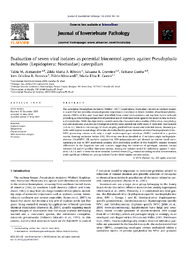Evaluation of seven viral isolates as potential biocontrol agents against Pseudoplusia includens (Lepidoptera: Noctuidae) caterpillars.
Evaluation of seven viral isolates as potential biocontrol agents against Pseudoplusia includens (Lepidoptera: Noctuidae) caterpillars.
Author(s): ALEXANDRE, T. M.; RIBEIRO, Z. M. A.; CRAVEIRO, S. R.; CUNHA, F.; FONSECA, I. C. B.; MOSCARDI, F.; CASTRO, M. E. B.
Summary: The caterpillar Pseudoplusia includens (Walker, 1857) (Lepidoptera, Noctuidae), known as soybean looper, is a pest that has recently assumed greater importance in soybean in Brazil. Isolates of nucleopolyhedroviruses (NPVs) of this pest have been identified from cotton in Guatemala and soybean farms in Brazil, providing an interesting perspective of potential use of viral insecticide against the insect in lieu to chemical insecticides. With the objective to contribute to the characterization studies of this virus, morphological and molecular analyses and biological activity were carried out with seven P. includens viral isolates (I-A to I-G). Electron microscopy of viral samples, purified from macerated infected larvae, showed particles with typical morphology of the Baculoviridae family, genus Alphabaculovirus (Nucleopolyhedrovirus – NPV) presenting virions with only a single nucleocapsid per envelope (SNPV) occluded in a protein matrix, forming occlusion bodies (OB). This virus was then classified as P. includens single nucleopolyhedrovirus (PsinSNPV). OB particles analyzed in SDS–polyacrylamide gel showed an intense band corresponding in size to NPV polyhedrin protein. DNA restriction profiles of the PsinSNPV isolates showed differences in the fragment size and number suggesting the existence of genotypic variants, except between I-E and I-F profiles that were similar. Among the isolates tested for infectivity against P. includens, I-A, I-E and I-F were the most virulent. Survival times (ST50) varied according to viral concentration, with significant differences among isolates for the three higher concentrations.
Publication year: 2010
Types of publication: Journal article
Keywords: Soja controle de pragas baculovirus
Observation
Some of Embrapa's publications are published as ePub files. To read them, use or download one of the following free software options to your computer or mobile device. Android: Google Play Books; IOS: iBooks; Windows and Linux: Calibre.
Access other publications
Access the Agricultural Research Database (BDPA) to consult Embrapa's full library collection and records.
Visit Embrapa Bookstore to purchase books and other publications sold by Embrapa.

